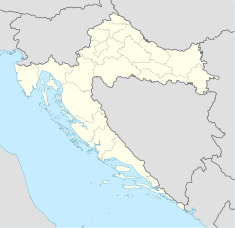Palace of Diocletian
| Historical Complex of Split with the Palace of Diocletian | |
|---|---|
|
Native name Croatian: Povijesna jezgra grada Splita s Dioklecijanovom palačom |
|

View of the peristyle (the central square within the Palace) towards the entrance of Diocletian's quarters
|
|
| Location | Split, Croatia |
| Coordinates | 43°30′30″N 16°26′24″E / 43.50833°N 16.44000°ECoordinates: 43°30′30″N 16°26′24″E / 43.50833°N 16.44000°E |
| Built | 4th century AD |
| Type | Cultural |
| Criteria | ii, iii, iv |
| Designated | 1979 (3rd Session) |
| Reference no. | 97 |
| State Party |
|
| Region | Europe |
| Official name: Dioklecijanova palača | |
Diocletian's Palace (Croatian: Dioklecijanova palača, pronounced [diɔklɛt͡sijǎːnɔʋa pǎlat͡ʃa]) is an ancient palace built for the Roman Emperor Diocletian at the turn of the fourth century AD, that today forms about half the old town of Split, Croatia. While it is referred to as a "palace" because of its intended use as the retirement residence of Diocletian, the term can be misleading as the structure is massive and more resembles a large fortress: about half of it was for Diocletian's personal use, and the rest housed the military garrison.
Diocletian built the massive palace in preparation for his retirement on 1 May 305 AD. It lies in a bay on the south side of a short peninsula running out from the Dalmatian coast, four miles from Salona, the capital of the Roman province of Dalmatia. The terrain slopes gently seaward and is typical karst, consisting of low limestone ridges running east to west with marl in the clefts between them.
After the Romans abandoned the site, the Palace remained empty for several centuries. In the 7th century, nearby residents fled to the walled palace in an effort to escape invading Croats. Since then the palace has been occupied, with residents making their homes and businesses within the palace basement and directly in its walls. Today many restaurants and shops, and some homes, can still be found within the walls.
After the Middle Ages the palace was virtually unknown in the rest of Europe until the Scottish neo-classical architect Robert Adam had the ruins surveyed and, with the aid of French artist and antiquary Charles-Louis Clérisseau and several draughtsmen, published Ruins of the Palace of the Emperor Diocletian at Spalatro in Dalmatia (London, 1764).
...
Wikipedia

